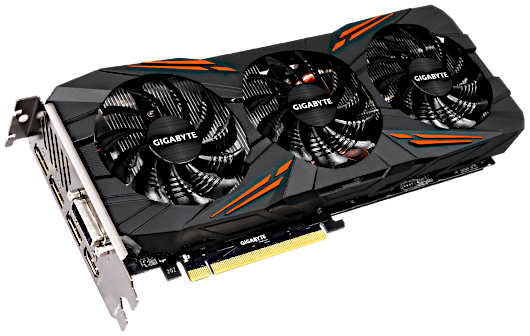Acquired new October 2024.
CPU: Intel Core i9-14900HX 24 64-bit cores (8 Hyperthreaded
performance cores, 16 efficiency cores, 32 threads total),
up to 5.8 GHz boost clock speed.
RAM: 32 GB DDR5 5600 (expandable to at least 64 GB*)
Storage: Internal: Samsung 1 TB NVMe SSD,
available slot for second NVMe drive,
also MicroSD card slot.
External: Two Thunderbolt 4 ports support multiple high
speed (up to 40 Gbps) storage devices.
Screen: 18" IPS 1920 x 1200 pixels 165 Hz 3 millisecond response
time, 100% sRGB coverage, with Nvidia G-Sync and
Advanced Optimus.
Graphics: Nvidia Geforce RTX 4060 GPU with 8 GB VRAM and
3,072 CUDA cores, rated at 233 Trillion Operations
Per Second ("TOPS") for AI.
Also Intel UHD Graphics 770 with 32 EUs integrated
into CPU.
One external monitor up to 8K can be connected to the
HDMI 2.1 port, plus four 4K or two 8K monitors can be
connected via the two Thunderbolt ports.
Audio: Stereo speakers, DTS X support,
headphone / microphone jack.
Connectivity: WiFi 6E, Ethernet 2.5 Gbps, Bluetooth 5.3,
Two Thunderbolt 4 ports @ 40 Gbps,
plus three USB-A 3.2 Gen 2 ports @ 10 Gbps.
Cameras: Webcam 720p
Misc: RGB backlit keyboard and lid logo.
OS: Windows 11 Home
My old HP Omen 17 from 2016 (see below) developed a stress crack on its plastic body while I was in Spain, so while it still works (for now), it was time to buy a more modern laptop.
Picked this machine up on sale for only $1,250; the regular price is $1,650. The body has an aluminum metal lid and deck, so hopefully it will not develop any cracks like my HP laptop. The 18" screen is massive and beautiful, but in consequence this laptop is on the heavy side at 7.5 lbs.
The Core i9-14900HX "Raptor Lake" 24 core / 32 thread CPU is currently the most powerful mobile CPU Intel makes. The downside with Raptor Lake processors is that they run hot under full load and consume more power than AMD CPUs. Fortunately this machine has 4 different power profiles that can be selected using a dedicated button above the keyboard, so the level of power consumption and fan speeds can be chosen as needed for the situation.
Besides gaming, the built-in Nvidia RTX 4060 GPU can also perform a wide range of AI tasks with 3,072 CUDA cores producing an impressive AI score of 233 Trillion Operations Per Second ("TOPS").
This is my first laptop with Thunderbolt ports. These ports run up to 40 gigabits per second and can support a variety of external devices including displays (two 4K screens per port) and high-speed storage devices. They can even support PCI Express devices such as external GPUs.
Acer's product page link.
* Some memory makers claim their 48 GB SODIMMs are compatible with this laptop, which would allow expanding to 96 GB of RAM.

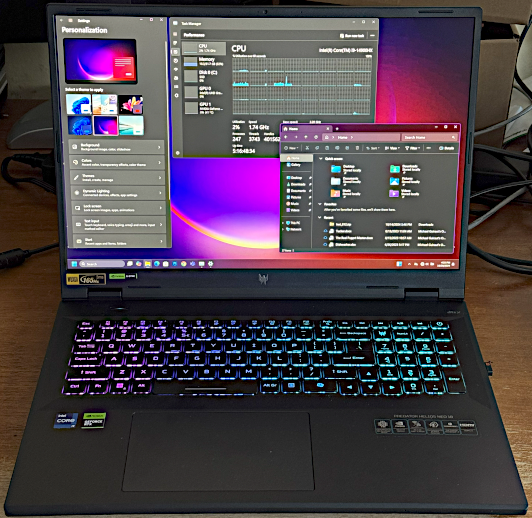
Acquired new May 2024.
CPU: Apple A17 Pro 64-bit SoC 6 cores up to 3.78 GHz,
also 16 core Apple Neural Engine, rated at 35 Trillion
Operations Per Second (TOPS) for AI.
RAM: 8 GB (not expandable)
Storage: 512 GB NVMe NAND internal (not expandable),
also support for USB-C external storage.
Screen: 6.7" OLED 2796 x 1290 pixels HDR multitouch,
120 Hz, 2000 nits peak brightness,
also provides low-power "always on" display.
Graphics: Apple 6 core proprietary GPU,
with hardware-accelerated ray tracing.
Audio: Stereo speakers, Dolby Atmos support,
earbuds supported via USB-C.
Connectivity: Cellular, WiFi 6E (802.11ax), Bluetooth 5.3, NFC,
USB-C 10 Gbps.
Emergency SOS and roadside assistance
communication via satellite.
Cameras: Back:
48 megapixel with medium wide angle (24 mm*) lens
and virtual 2x (48 mm) coverage at 12 megapixels,
12 megapixel with ultra wide angle (13 mm) lens,
12 megapixel with 5x telephoto (120 mm) lens.
Front:
12 megapixel with medium (23 mm) wide angle lens.
Video: Up to 4K 60 fps HDR Apple ProRes Raw
Misc: Built-in GPS, accelerometer, gyro, compass, lidar,
barometer, wireless charging.
OS: Apple iOS 18
After using my iPhone 7 Plus (which I still have) for 8 years, decided for my trip to Spain to upgrade to a newer phone. Took both phones to Europe since the old 7 Plus uses physical SIM cards, making it easier to change it to a European carrier as a backup phone.
I decided to upgrade to this model in particular since it introduces some significant technical changes to the iPhone line, such as the 5x telephoto lens, compatibility with Apple's upcoming artificial intelligence features and USB-C (available on all iPhone 15s and a welcome change from the fragile, proprietary and technically obsolescent Lightning connector).
* Note that all camera lens focal lengths are expressed in their 35mm film camera equivalents.
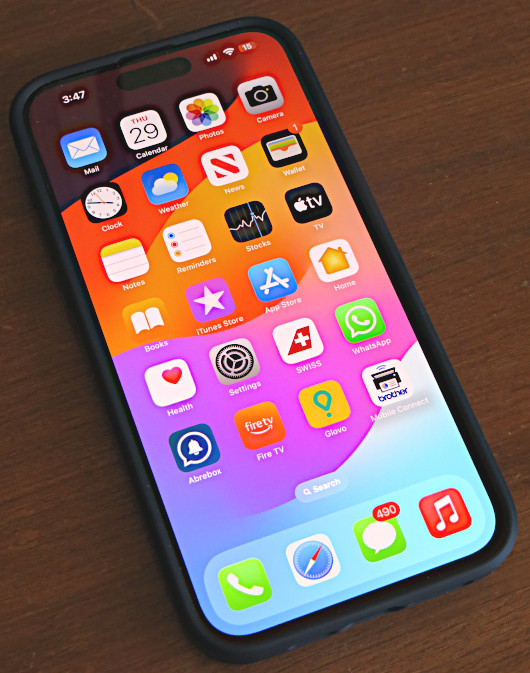
Built June 2023.
CPU: AMD Ryzen 9 7900 12 Hyperthreaded 64-bit performance
cores (24 threads total), base clock 3.7 GHz,
max boost 5.4 GHz.
RAM: 64 GB Corsair Vengeance DDR5 5600
(system max is 96 GB)
Chipset: AMD B650
Motherbd: Asrock B650M-HDV/M.2
Storage: Boot Drive:
2 TB Samsung 990 Pro M.2 NVMe SSD
Storage Drive:
2 TB Samsung 980 Pro M.2 NVMe SSD
Optical Drive:
LG WH16NS40 16X Blu-Ray SATA burner
writes Blu-ray discs up to quad-layer 128 GB BDXL,
also long-life M-DISC format and DVD / CDs.
External:
18 TB Western Digital Elements drive (USB 3).
14 TB Western Digital EasyStore drive (USB 3).
Two Thunderbolt 4 ports support multiple high
speed (up to 40 Gbps) storage devices.
Total system storage: 36 Terabytes
Graphics: Asus Nvidia Geforce RTX 2070 with 8 GB GDDR6 VRAM
and 2,304 CUDA cores, supports up to four monitors at
up to 8K (7680 x 4320) resolution, also
AMD Radeon RDNA 2 integrated graphics (built into CPU).
Monitors: 2 x 29" 2560 x 1080 LG Ultrawide 29" IPS LCDs.
1 x 24" 1920 x 1200 Dell IPS LCD.
Audio: Realtek ALC897 7.1 channel 192 kHz HD Audio,
connected to Logitech X-530 70 watt 5.1 speaker set.
Power
Supply: Corsair RM850x 850 watt modular
UPS: CyberPower CP1500PFCLCD
1,500 Volt-Amp / 1,000 watts backup power.
Case: Fractal Design Pop Air
Connectivity: Ethernet 2.5 Gbps, USB 3.x 10 Gbps, also USB 2.0,
two Thunderbolt 4 ports @ 40 Gbps.
Misc: Razor Black Widow Elite RGB keyboard
OS: Windows 11 Professional 64-bit
After 10 years using my Custom SuperPC #2 (see below) as my main business / development system, it was time to build a new one. This is the first X86-compatible system I have ever built using an AMD processor instead of Intel. The reasons for switching to team red were clear - in the last few years, AMD has pulled ahead of team blue in the technology race. While Intel has mostly caught up on the performance charts with its latest 13th generation Core processor line, it has been at the cost of massively increased power consumption and heat.
In contrast, the AMD Ryzen 9 7900 used in this build is currently one of the most power-efficient processors available, with 12 hyper-threaded performance cores consuming only 65 to 88 watts of power depending upon load - the entire system only consumes around 83 watts idling on the Windows desktop. At full load with all 12 cores at 100%, system power consumption is 170 watts. With the RTX graphics card running the modern ray-traced game Cyberpunk 2077, total system power consumption climbs to 310 watts - still impressive, considering that an equivalent Intel system can consume that much power just for the CPU itself.
YouTube Channel "Hardware Unboxed" was impressed with the performance of the inexpensive Asrock B650 motherboard I used; see their review here: www.youtube.com/watch?v=ekeTA1rds1s
The LG optical drive can write discs up to 128 GB in size (quad-layer BDXL-R), also can burn the special M-DISC format which is claimed to have a storage life of up to 1,000 years.
The CyberPower CP1500PFCLCD UPS can keep the system going for around 40 minutes in the event of a power failure. I also recently acquired an AI Power SC2400iP gas powered inverter generator that can keep this system plus of course our refrigerator, house lights, etc., powered indefinitely in case of a longer term power failure.
A number of components were recycled from SuperPC #2 (see below), including the Asus RTX graphics card, Samsung 980 Pro SSD and of course all the peripherals connected to that system.
12/24: Installed Asrock Thunderbolt 4 AIC card designed to work with the Asrock motherboard. This added two Thunderbolt 4 ports able to support multiple storage and display devices, etc. up to 40 Gbps each. I now have four computers that can share Thunderbolt devices - my Acer 18" laptop (see above), this computer, the Apple Mac Mini (see below) and the custom PC #2 from 2013 (below) that has the original version of Thunderbolt.
Attached Printers & Scanners:
Canon imageCLASS MF4770n B&W laser
printer / scanner donated by a friend. This is
currently the primary printer for the system.
Canon PIXMA Pro 9000 large-format
professional color photo printer - uses eight ink
colors and makes prints up to 13" x 19" in size.
Epson Workforce WF-3640 printer / scanner.
This machine can do both automatic double-sided
scanning and printing. Best of all, it was acquired
in good condition from the local Goodwill for only
$25 (all the ink cartridges did need to be replaced).
Epson Perfection V500 Photo scanner. This is
a high quality photo and film scanner with a
native hardware resolution of 6400 x 9600 dpi;
it can create a digital image up to 4 Gigapixels (!)
in size from an 8.5" by 11.7" original. Also has
hardware support for Digital ICE, a technology
for deleting dust spots, etc. from film negatives.
I also have a Brother P-touch PT-1230 label printer
that can be connected when needed (see pic below).

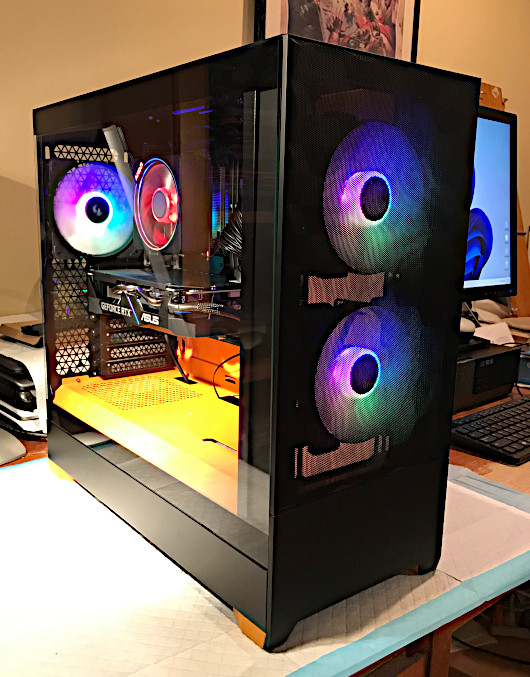

Asrock B650M-HDV/M.2 motherboard
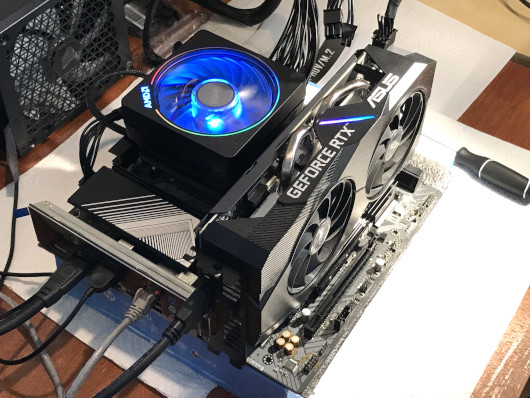
Testing components before mounting in case
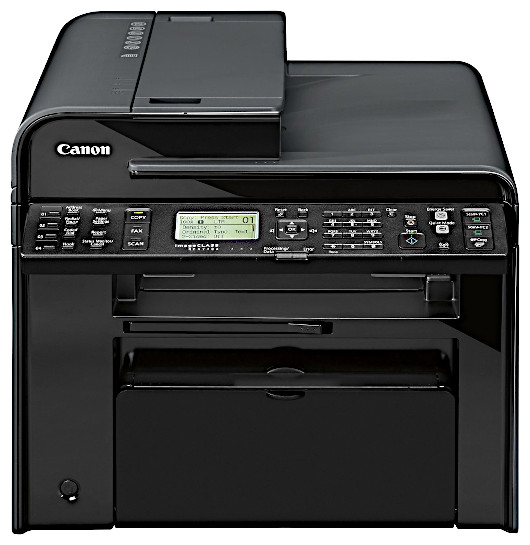
Canon imageCLASS b&w laser printer

Canon Pro900 large-format color photo printer

Epson WF-3640 color printer / scanner

Epson V500 Photo scanner
Made 2021; acquired refurbished December 2024.
CPU: Apple S7 SiP two 64-bit cores @ 1.86 GHz,
based upon Apple A13 efficiency cores.
RAM: 1 GB (not expandable)
Storage: 32 GB NAND internal (not expandable)
Screen: 1.9" OLED "Retina" 396 × 484 pixels multitouch,
1000 nits peak brightness,
also provides low-power "always on" display.
Graphics: Apple proprietary GPU built into CPU SiP.
Audio: Built-in mono speaker, microphone,
stereo earbuds supported via Bluetooth.
Connectivity: LTE Cellular, WiFi 802.11 b/g/n, Bluetooth 5.0,
Ultra Wideband.
Navigation: GPS, GLONASS, Galileo, QZSS, and BeiDoux.
Sensors: Optical heart sensor, electrical heart sensor (ECG/EKG),
blood oxygen sensor, temperature, accelerometer (to 32g),
gyroscope, ambient light, sound, altimeter and compass.
Misc: Water resistant up to 50 meters, IP6X dust resistant,
magnetic wireless charging.
OS: Apple watchOS 11
My first computer watch, replacing my ancient Casio electronic watch that I stopped wearing many years ago. Of course I got an Apple one, since it integrates closely with both of my iPhones. This model as configured cost $500 new back in 2021; purchased it refurbished in excellent condition for $184 in December '24.
This model is notable in that it contains the blood oxygen sensor that Apple was forced to remove from more recent versions (starting with the Series 9 and later), since the company was found to be infringing upon another company's patent (basically Apple tried to steal the tech by hiring away that company's employees instead of paying for a license).
Apple still has up the Series 7 announcement page, with a lot of good details and photos of what this watch can do.
Acquired new in 2021.
CPU: Armv8-A Cortex Six Core 64-bit
(four 2.2 GHz Cortex-A73 "big" cores
and two 1.9 GHz Cortex-A53 "little" cores)
RAM: 2 GB DDR4 (non-expandable)
Storage: Internal 16 GB Flash for apps (non-expandable),
Micro-USB connector supports external storage.
Graphics: Mali G52 MP2, up to 4K HDR via HDMI.
Hardware video decode support for MPEG-4,
MPEG-2, H.263, H.264, H.265, VP8 and VP9.
Audio: Dolby Atmos, 7.1 surround, also 2 channel stereo.
Connectivity: WiFi 802.11 a/b/g/h/n/ac 2x2 MIMO dual
antennas, Bluetooth 4.1, USB.
Misc: Built-in microphone & speaker for Alexa voice
commands (can be turned-off).
OS: Fire OS (customized version of Android)
This replaced the older Amazon Fire Stick attached to my 4K TV. It is a video streaming device that supports all the major streaming services such as Netflix, Disney+, Paramount+, YouTube, etc. as well as Amazon's own Prime Video.
It can also run other kinds of apps such as video games.
It has a built-in microphone & speaker for Amazon's speech recognition & natural language processing technology, Alexa. Voice commands can be used to control video search, selection and playback. Alexa can also be used for ordering stuff (from Amazon of course!) and also supports real-time knowledge queries, such as "Alexa, what is the current weather forecast?".
Acquired new in 2019.
CPU: Custom version of AMD's Jaguar X86 64-bit 8 Core APU
@1.75GHz clock speed.
RAM: 8 GB DDR3 (non-expandable),
also 32 MB of super high-speed ESRAM.
Storage: 1 TB Hard Drive 2.5" 5400 rpm
8 GB Flash
4K UHD Blu-ray / DVD / CD Optical drive
USB 3.x ports support external storage drives.
Graphics: Custom AMD GPU @ 914 MHz,
12 Radeon Compute Units (1.4 TFLOPS),
up to 4K 2160p resolution @ 60 Hz with HDR supported.
Audio: Dolby Digital 5.1, DTS 5.1, PCM up to 7.1;
also Dolby TrueHD w/Atmos in games.
Connectivity: WiFi 802.11 a/b,
Wired Ethernet 1 Gigabit,
dedicated dual band Xbox Wireless radio for accessories,
USB 3.x, both HDMI in and out.
Misc: Two wireless Xbox One game controllers.
OS: Hyper-V hypervisor running dual virtual machines
based upon Windows 10 core;
one VM runs games while the second hosts the
user interface & Windows 10 universal apps.
Acquired this new for $249 bundled with a copy of one of the Forza Horizon driving games. I use this machine connected to my 4K TV to play 4K blu-ray movies, games and streaming video apps such as Paramount Plus (discs and streaming video are native 4K, but games I believe are up-converted from 1080p). This is my third Xbox console; I also have an Xbox 360 I bought back when they were new, and before that the original Xbox from 2001 (see my obsolete computer page for details). Happily the Xbox One is backward compatible with most of my Xbox 360 games.
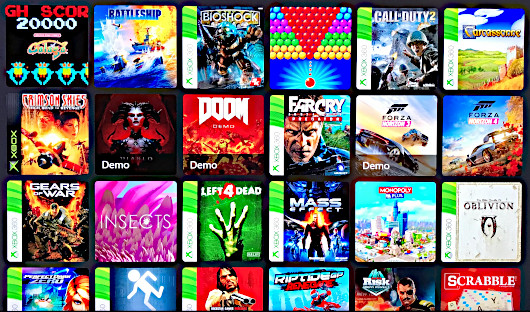
Some of the games currently installed on the Xbox One
Made 2019; acquired refurbished in 2024.
CPU: Apple A12 Bionic 64-bit 6 compute cores, 8 Neural cores,
plus M12 Motion co-processor.
RAM: 3 GB LPDDR4X (not expandable)
Storage: 256 GB internal NAND (not expandable)
Screen: 10.5" IPS LED 2224 x 1668 pixels laminated
wide color (P3) "true tone", multitouch.
Graphics: Apple proprietary 4 core
with HDMI & analog video/audio out via
Lightning adapter.
Audio: Stereo speakers, headphone jack.
Connectivity: Cellular data Gigabit-class LTE,
WiFi 802.11 a/b/g/n/ac, Bluetooth 5.0,
Apple Lightning connector, USB 2.0.
Misc: Two cameras, 8 Megapixel rear and 7 Mp front.
Built-in GPS, accelerometer, gyro, compass,
barometer and finger-print scanner.
OS: Apple iPadOS 18
This replaced my iPad Air 2 (see below) with its worn-out Lightning port*.
Acquired refurbished in excellent condition for $279 plus $47 for a 2 year warranty plan. In comparison, a new iPad Air 5 with 256 GB and cellular modem costs at least $750 and comes with only a one year warranty.
I have found that this iPad is actually faster on a cellular connection (around 120 Megabits/sec) than on WiFi (65 Mb/sec).
* The Lightning ports are a weak point with iPads; my wife's 2017 iPad Pro also failed with the same problem. Unfortunately Apple made these ports uneconomical to repair; and since the port is used to power & charge the device, its failure makes these expensive tablets useless.
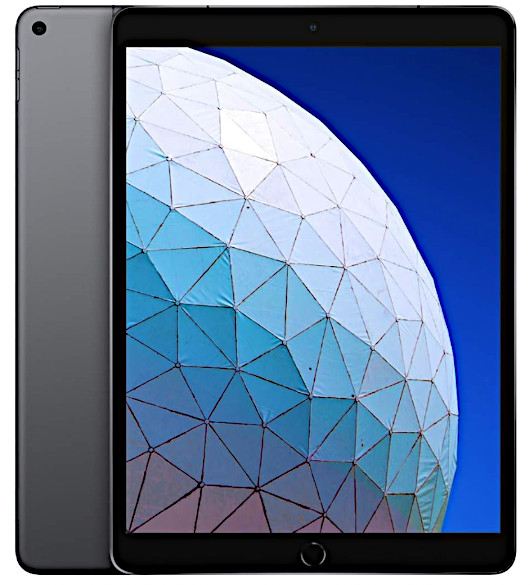
Made 2018, acquired refurbished November 2024.
CPU: Intel Core i5-8500B 6 cores 64-bit 3.0 GHz,
plus Apple T2 co-processor 4 cores 64-bit (based
upon Apple A10 CPU) handles security, disk I-O, etc.
RAM: 32 GB DDR4 2666 (expandable to 64 GB) for Intel CPU.
1 GB DDR4 for Apple T2 co-processor (not expandable).
Storage: Internal: 512 GB PCIe-based SSD (not expandable).
External: 1 TB Samsung 990 Pro in Acasis Thunderbolt
enclosure; a total of four Thunderbolt 3 ports support
multiple high speed (up to 40 Gbps) storage devices.
Graphics: Intel UHD Graphics 630 integrated into CPU.
One external monitor up to 5K can be connected to the
HDMI 2.0 port, plus two more 4K monitors can be
connected via the Thunderbolt ports.
Monitor: Currently Asus 24" 1920 x 1200 IPS LCD.
Audio: Built-in speaker, headphone / speaker jack.
Connectivity: WiFi 802.11ac, Ethernet 1 Gbps, Bluetooth 5.0,
Four Thunderbolt 3 ports @ 40 Gbps,
plus two USB-A 3.0 ports @ 5 Gbps.
OS: MacOS 15 Sequoia
and Windows 10 in dual boot configuration
using Apple Boot Camp.
This Mac cost $1,400 new back in 2018; picked it up refurbished with an 90 day warranty for $284 in late 2024.
I purchased this computer to explore iPhone / iPad app development (which requires a Mac capable of running either the current MacOS or one version back), also to catch-up on using the latest MacOS.
This was the last Mac Mini with an Intel CPU, last one with expandable memory, last one able to support an external GPU and the last one able to boot into either MacOS or Windows. It's also one of the few Intel Macs still officially supported by the latest MacOS release as of late 2024, "Sequoia".
The Apple T2 co-processor is a "computer within a computer" with its own dedicated 1 GB of memory and operating system (bridgeOS). It is based upon the same A10 CPU that is in my old iPhone 7 Plus (see below). Apple uses this co-processor for a variety of tasks including disk management, encryption and video codec acceleration.
2/25: Installed Windows 10 as a boot option using Apple Boot Camp. Partitioned the internal SSD so that Windows 10 has 128 GB of space and MacOS has the rest. So far I'm impressed with how well Boot Camp is working; Windows 10 runs fine, and in MacOS I can actually see and interact with the files stored on the Windows partition. Also upgraded memory from 8 GB to 32 GB for $60 using OWC 16GB SO-DIMMS.
Front & back views
MacOS Sequoia desktop
Made in 2018; acquired refurbished in 2023.
CPU: Freescale 6SLL Cortex A9 1 GHz 32-bit
RAM: 512 MB (non-expandable)
Storage: 8 GB Flash (non-expandable)
Screen: 6" E-Ink Pearl Carta touchscreen 1448 x 1072
pixels (300 ppi) greyscale capacitive touchscreen,
with 5 LED frontlights.
Graphics: Unknown
Audio: Audible Audiobook support via Bluetooth
Connectivity: WiFi 802.11 a/b/g/n,
Bluetooth 4.2, USB 2.0.
Misc: Water-proof IPX8 rating,
1500 mAh battery.
OS: Customized version of Android
Picked this up refurbished from Woot! for $40 (originally cost $129 in 2018). This is the fourth version of Amazon's paperwhite Kindle e-ink reader, and it belongs in the 10th generation family of Kindle devices; the first generation Kindle was released back in 2007. All Kindles use e-ink "electronic paper" displays. These mimic the appearance of ink on a sheet of white paper and the screen can be read in direct sunlight. For evening use, there are five LED front-lights built-in. With the LEDs off, these devices use almost no electricity when displaying a static page; battery life in such a state can last for weeks.
Document and image formats that can be read include Kindle Format 8 (AZW3), Kindle (AZW), TXT, PDF, unprotected MOBI, PRC natively; HTML DOC, DOCX, JPEG, GIF, PNG, PMP through conversion; also Manga comics & Audible audio format (AAX). There is a basic web browser built-in.
With an IPX8 rating, this device can survive being immersed in water up to a depth of 6 feet for 60 minutes.

Made in 2017; acquired refurbished in 2022.
CPU: Armv8-A Cortex Quad Core 64-bit
(two 1.8 GHz Cortex-A72 "big" cores
and two 1.4 GHz Cortex-A53 "little" cores)
RAM: 2 GB (non-expandable)
Storage: 32 GB internal flash (non-expandable),
256 GB Sandisk Extreme card in microSDXC card slot.
Screen: 10.1" LCD IPS 1920 x 1200 pixels
Graphics: PowerVR G6250
Audio: Stereo speakers, headphone jack,
microphone.
Connectivity: WiFi 802.11 a/b/g/h/n/ac,
Bluetooth 4.1, USB 3.0, 2.0.
Misc: Built-in 720p & 480p cameras,
accelerometer.
OS: Fire 5.7 (customized version of
Android 5.1 "Lollipop").
After my Apple iPad Air 2 (see below) became inoperable at the end of 2022 due to a worn-out charging connector that Apple unfortunately made non-replaceable, I needed another tablet but I didn't want to spend $600 on the latest iPad Air. Luckily Woot! was having a flash sale on this Amazon tablet, refurbished, for only $21!
The tablet arrived in like-new condition and has for the most part effectively replaced my broken-down iPad. Build quality is not at Apple's level, but is decent; the screen is a good quality IPS panel with 1080p+ resolution. This tablet originally sold for $150 in 2017, which was probably close to the cost to manufacture it. It's well known that Amazon prices their tablets low with the intent to make their profit on content.
A negative point is that, unlike what Apple did with my old iPad Air 2, Amazon is similar to the Android phone makers in that they usually offer only minor updates to the customized version of Android they install on each generation of their tablets. So this 7th generation device is stuck on Fire OS 5.x; gen eight through eleven is on Fire 7.x, and only the latest 12th generation (2022) devices get their latest OS which is 8.x.

Acquired new in 2016.
CPU: Intel Atom x5 Z8300 Quad-Core 64-bit
RAM: 2 GB (non-expandable)
Storage: 32 GB Flash (non-expandable),
microSDXC card slot (128 GB card currently
installed).
Screen: 11.6" IPS LCD 1920 x 1080 pixels multi-touch
Graphics: Intel integrated into the CPU, supports
up to two displays @ 1920 x 1080.
Audio: Stereo speakers, headphone jack,
microphone.
Connectivity: WiFi 802.11 a/b/g/h/n/ac,
Bluetooth 4.1, USB 3.0 Type C,
micro HDMI.
Misc: Detachable keyboard, 2 megapixel &
5 megapixel cameras, GPS, G-sensor,
E-compass, gyroscope,
ambient light sensor.
OS: Microsoft Windows 10 64-bit.
Acquired for Windows tablet software development & testing, this tablet can be dropped into the included keyboard "dock" which effectively turns it into a small laptop. At less than $200 new, this is a low-end device that works fine for web surfing, emails and video playback. The ancient "Call of Duty 1" game runs fine on it, but more demanding games would likely be a slide-show.
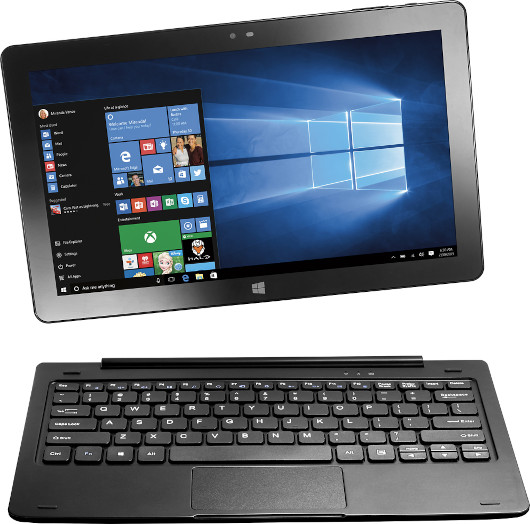
Acquired new in 2016.
CPU: Intel i7-6700HQ Quad Core 64-bit Hyperthreaded
(8 threads total), base clock 2.6 GHz, max boost 3.5 GHz.
RAM: 24 GB DDR4 (expandable to 32 GB)
Storage: 1 TB Samsung SSD 980 Pro M.2 (NVMe) drive,
available bay for a second internal SSD,
plus DVD+-RW DL/CD-RW optical drive,
SD memory card slot.
Screen: 17" LCD IPS matte 1920 x 1080 pixels
Graphics: Nvidia Geforce GTX 965M with 2 GB GDDR5 VRAM,
also Intel HD Graphics 530 integrated into
the CPU.
Audio: Intel audio with Bang & Olufsen speakers,
microphone, line-in and out.
Connectivity: Ethernet 1 Gb, WiFi 802.11 a/b/g/h/n/ac,
Bluetooth, USB 3.0, 2.0.
Misc: Built-in camera, back-lit keyboard.
OS: Microsoft Windows 10 64-bit.
Until I bought my Acer Predator 18 (see above) in October '24, this was my most powerful laptop. The machine seamlessly switches between its two GPUs as needed - on battery, it uses the power-saving Intel HD graphics; when connected to AC power, it automatically switches to the Nvidia GPU.
Originally this machine came with an old-fashioned rotating drive and only 12 GB of RAM; this made it a bit less expensive to buy than other i7 laptops at the time. Officially the memory was not supposed to be expandable; but in 2021 I replaced one of the two DIMMs in the system and successfully got total memory up to 24 GB. If I replace the second original DIMM I could get to 32 GB, but 24 GB is more than enough for the kind of development work I do. The rotating drive was definitely a drag on performance; so around the same time I upgraded the memory I replaced the hard drive with a super fast Samsung 980 Pro SSD.
October 2024 Update: Despite being carefully handled at all times, this machine developed a serious stress crack next to the right-hand screen hinge (other owners have reported the same problem). The machine is currently still working, but since the crack is in the section where the power cable connects, it's possible that eventually internal circuitry will be damaged as the crack continues to grow.
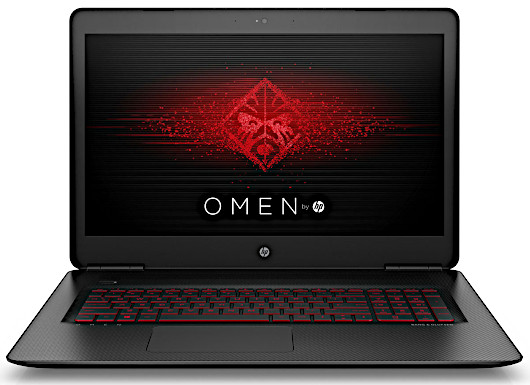
Acquired new in 2016.
CPU: Apple A10 Fusion 64-bit Quad Core 2.3 GHz
64-bit, plus M10 Motion co-processor.
RAM: 3 GB (not expandable)
Storage: 256 GB internal (not expandable)
Screen: 5.5" IPS LED 1920 x 1080 pixels multitouch.
Graphics: Apple customized version of the PowerVR
GT7600 with 6 cores.
Audio: Stereo speakers, also via supplied ear-buds using
the included Lightning-to-headphone adapter.
Connectivity: WiFi 802.11 a/b/g/n/a, Bluetooth 4.2,
Apple Lightning connector, USB 2.0.
Cameras: 12 megapixel on back with wideangle lens,
12 megapixel on back with 2x telephoto lens,
7 megapixel on front with standard lens.
Misc: Built-in accelerometer, gyro, compass,
barometer and finger-print scanner.
OS: Originally Apple iOS 10, final version 15.7.
Even though I follow the usual security practices, my Samsung Android cell phone got remotely hacked in 2016 due to numerous remote-access security holes in the Android operating system. I decided to change over to Apple's iOS which does have a reputation for better security than Android. This reputation appears to be deserved, since as of 2023 this phone has never shown any sign of being hacked.

Acquired new April 2015.
CPU: Apple A8X Triple Core 1.5 GHz 64-bit,
plus M8 Motion co-processor.
RAM: 2 GB (not expandable)
Storage: 64 GB internal NAND (not expandable)
Screen: 9.7" IPS LED 2048 x 1536 pixels
multitouch.
Graphics: Apple proprietary, based upon
Imagination PowerVR Series6XT design,
with HDMI & analog video/audio out via
Lightning adapter.
Audio: Stereo speakers, headphone jack.
Connectivity: WiFi 802.11 a/b/g/n/a, Bluetooth 4.0,
Apple Lightning connector, USB 2.0.
Misc: Two cameras, 8 Megapixel rear and 1.2 Mp front.
Built-in accelerometer, gyro, compass,
barometer and finger-print scanner.
OS: Originally Apple iOS 8.3, later 15.x.
A beautiful screen, excellent build quality, speedy performance and at a weight of only one pound, this was arguably one of Apple's best tablets at the time. The only drawback is that, like a lot of their devices, it wasn't designed to be repairable, which did result in negative consequences down the road (see below).
I also got a lightweight Inateck Bluetooth keyboard for times when I may need to do some serious typing.
2022 Update: This device is now inoperable due to a worn-out charging connector that Apple unfortunately made non-replaceable. It is very frustrating that a device that originally cost $600 has become unusable due to the failure of a $2 part.
2024 Update: Bought a refurbished iPad Air 3 (see above) to replace this, after making do for a year with my Amazon Fire HD tablet that I got for $21 (also see above).

Acquired February 2015.
CPU: ARM Cortex-A7 900 MHz 32-bit Quad Core
RAM: 1 GB (not expandable)
Storage: Micro SD slot supports up to 64 GB
(32 GB card currently installed).
Graphics: VideoCore IV 3D graphics dual core,
up to 1920 × 1200 resolution,
with HDMI & analog video / audio out.
Audio: Stereo
Connectivity: Ethernet 10/100 Mbps, four USB 2.0 ports.
Misc: 40 GPIO pins for custom input/output
OS: Various versions of Linux supported,
also Windows 10 RT (see below).
Raspbian Debian currently installed.
This credit-card sized computer, belonging to the popular line of Raspberry Pi devices for hobbyists and students, cost only $35 and packs a lot of power in a tiny space. A variety of Linux operating systems are supported, and Microsoft has announced a special version of Windows 10 will be available for it (based upon the 'RT' edition, not compatible with x86 apps). This board has a substantial cottage industry of add-ons and accessories available.
The Videocore GPU supports OpenGL-ES and full 1080p H.264 video encode / decode.
2020 Update: Acquired for free a PiFace Digital 2 daughter-board for the Pi card which acts as an interface for outside sensors and switches.


PiFace daughter board
Acquired December 2014.
CPU: Intel Celeron N2830 2.16Ghz Dual Core 64-bit
with 1 MB cache.
RAM: 8 GB (max capacity)
Storage: Samsung 860 EVO 250 GB SATA SSD
(originally had 500 GB rotating drive),
plus SD card reader.
Screen: 19.5" 1600 x 900 pixels, multi-point touch.
Graphics: Intel HD Integrated Graphics DirectX 11
Audio: Realtek ALC290Q with Waves MaxxAudio 5,
stereo speakers and subwoofer.
Connectivity: WiFi b/g/n, Ethernet 10/100 Mbps,
Bluetooth 4.0, three USB 2.0 ports,
HDMI in, Miracast.
Misc: Front-facing webcam (720p)
OS: Microsoft Windows 10 64-bit
(originally Windows 8.1).
Our first touch-screen "all-in-one" Windows desktop PC. It's like a giant tablet that plugs into the wall (there is an optional battery available!), with a wireless keyboard and mouse.
I got this for my wife, plus also for testing my Visual Studio applications on a desktop-sized touch screen. This was our second Windows 8.1 machine, after the Asus Vivotab I purchased earlier in the month (see below).
2021 Update: Replaced old rotating drive with Samsung SSD, upgraded to Windows 10. The RAM can also be upgraded but I have not done it so far since the upgrade requires that the machine be entirely disassembled (finally done in 2024 - see below).
2023 Update: Gave my wife an iMac (see below). This machine now is being used both as a Windows 10 PC and as a second monitor for my Dell Optiplex Linux machine (also see below), thanks to its fairly unique HDMI-in capability.
2024 Update: Coin battery needed replacement; since Dell decided to place the battery on the bottom of the motherboard, the machine had to be almost completely disassembled to get to it. Decided to upgrade the RAM from 4 GB to system max of 8 GB at the same time.
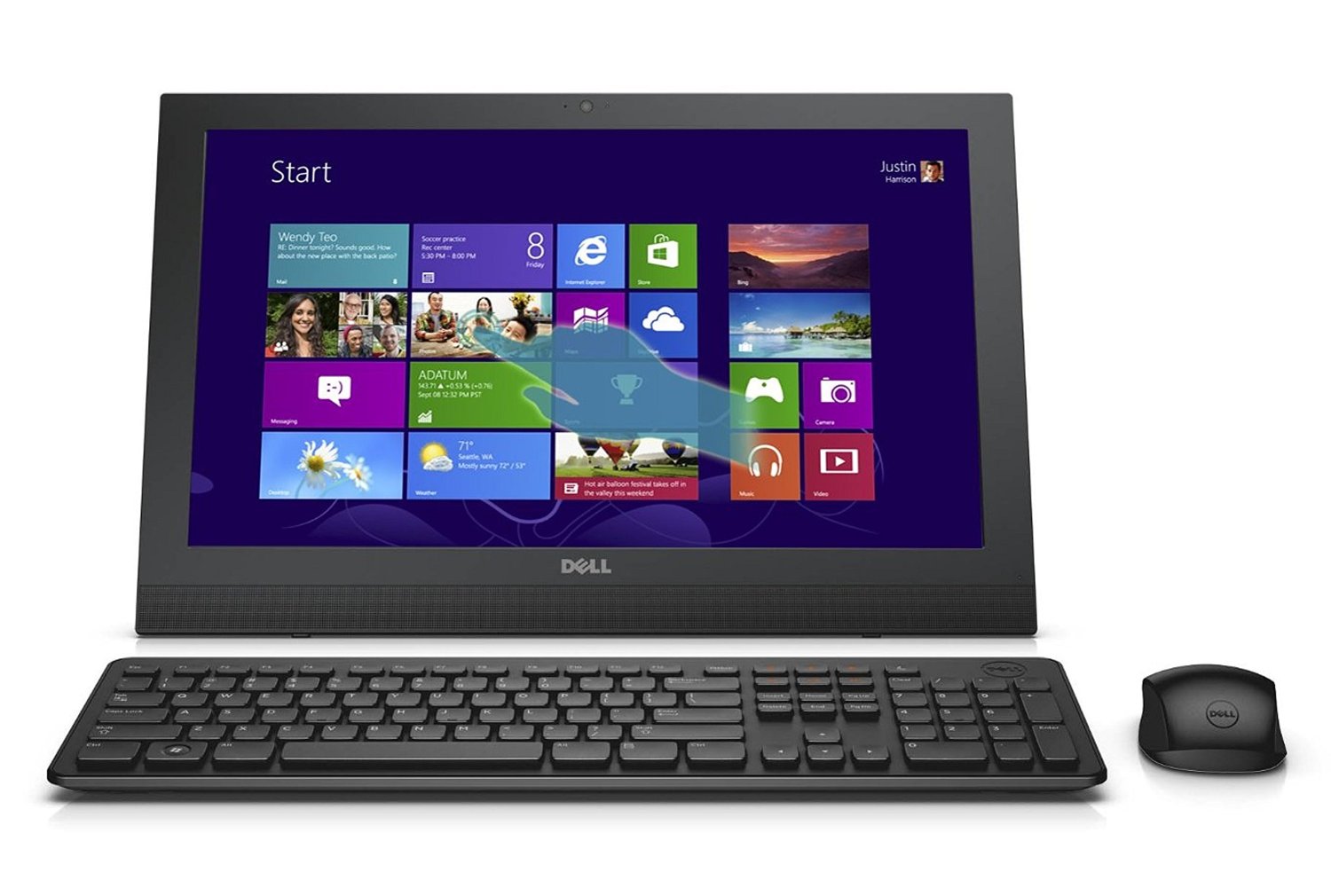
Acquired new December 2014.
CPU: Intel Atom Z3740 1.3 GHz quad-core
2 MB L2 cache.
RAM: 2 GB
Storage: 64 GB internal SSD, plus a MicroSD
card slot supports up to 64 GB,
total 128 GB storage max.
Screen: 8" IPS 1280 x 800 pixels, multi-point
touch with Wacom digitizer.
Graphics: Intel HD Integrated Graphics DirectX 11
Audio: Stereo Speakers with SonicMaster
Connectivity: WiFi b/g/n, Bluetooth 4.0, Miracast and
full USB port.
Misc: GPS built-in, both front (1.2 MP)
and back (5 MP) cameras.
OS: Microsoft Windows 8.1 full version
My first Windows 8 tablet. This reasonably-priced tablet runs the full version of Windows 8.1, and therefore is compatible with all Windows tablet & desktop (32 bit) applications including legacy software such as Microsoft Visual FoxPro.
Unlike Apple's iPad models at the time, this tablet came with a fully functional PC-style USB port. Printers, keyboards, barcode scanners and even old game controllers can be plugged-in to the port. The graphics power is sufficient to run older PC 3D games; see picture at right of the tablet running Left 4 Dead with an old USB Xbox controller that I had sitting on the shelf.

Completed March 2013.
My previous main business system (a water-cooled monster built in 2006 - see below) was getting a bit obsolete, with its 2005-era Pentium D and its nForce chipset that Nvidia has stopped supporting. It was past time to build a new system. In mid-January 2013 I had the new components operating on a table-top (see pic at right). In March I mounted the parts into a server-sized Lian-Li case. Some of the front panel bling I recycled from my old main system.
In the past eleven years this system has been greatly upgraded and was my main office and development system until replaced by my Custom SuperPC #3 project in June of 2023. The specs below reflect its current configuration:
CPU: Intel Core i7 3770K 4 Hyperthreaded 64-bit cores
(eight threads total), 3.5 regular to 3.9 GHz boost clock,
1 MB L2 cache, 8 MB L3 cache.
RAM: 32 GB DDR3 Corsair Vengeance
(maximum capacity)
Chipset: Intel Z77
Motherbd: Gigabyte Z77X-UP5-TH
Storage: Boot Drive:
512 GB Samsung 860 Pro SATA 3.0 (6 Gbit/s) SSD
Storage Drives:
1 TB Samsung 990 Pro M.2 NVMe SSD
on PCI-Express card.
Optical Drive:
Sony BR5100 SATA Blu-ray read-only drive.
Total system internal storage: 1.5 Terabytes
Graphics: Gigabyte Nvidia Geforce GTX 1080 G1 with 8 GB
GDDR5X VRAM, can support up to 4 monitors,
max resolution per monitor 8K (7680 x 4320).
Also Intel HD 4000 integrated graphics (built into CPU).
Audio: Realtek ALC898, X-Fi Xtreme Fidelity
and EAX® Advanced HD, 7.1 channel,
with S/PDIF out.
Power
Supply: Enermax 1,000 watt Revolution-87
Connectivity: USB 3.0, dual Thunderbolt ports, eSATA.
OS: Windows 10 Professional 64-bit
The Gigabyte motherboard doesn't support IDE or other "legacy" stuff such as PS2, RS-232 (serial) or parallel ports. Instead, it has the latest cutting-edge connectivity tech for 2013 - USB 3.0, eSata and dual Thunderbolt ports. The Thunderbolt ports support daisy-chaining up to 12 devices simultaneously with a bi-directional 10 Gbps data pipeline that is able to carry both PCI Express and DisplayPort traffic.
When first built in 2013, a refurbished Nvidia GTX 280 card was installed. In 2015, this was replaced with two refurbished 580 cards joined in an SLI configuration so I could play Crysis with decent performance. After the 580s proved to be too noisy & troublesome, I purchased a new Gigabyte GTX 960 "Windforce" which performed almost as fast as the two 580s, but was dramatically cooler and quieter. In 2020 the 960 was replaced with a new RTX 2070, but in 2023 I needed to use the RTX for my new SuperPC #3 build (see above), so the 960 was put back in.
11/23 Update: Replaced the Gigabyte GTX 960 2 GB with a bit newer and definitely more powerful Gigabyte GTX 1080 G1 8 GB card (see below). Also added the Samsung 990 Pro NvMe SSD drive using a NvMe-to-PCI-Express adapter, to replace an 2 TB Western Digital Blue rotating SATA drive that failed.

Completed with front-panel bling from older Custom SuperPC #1

Gigabyte Motherboard Z77X-UP5-TH

Under construction
Made 2012, acquired 2016.
CPU: Intel i5-2500 Quad Core 3.3 GHz 64-bit
RAM: 16 GB DDR3 (maximum capacity)
Storage: 512 GB Samsung SSD 850 PRO,
DVD+-RW DL/CD-RW Optical drive.
Monitor(s): Asus 24" LCD IPS 1920 x 1200 pixels,
Dell 19.5" 1600 x 900 pixels.
Graphics: Nvidia Geforce GT 1030 with 2 GB of VRAM,
also Intel HD Graphics 2000 integrated
into the CPU with DP & VGA out.
Audio: Intel Q67 Express audio, stereo out,
microphone, line-in.
Connectivity: Ethernet 1 Gb, USB 2.0, serial port.
OS: Ubuntu Studio Linux 22.10 64-bit
(originally came with Microsoft Windows 7).
I acquired this system in 2016 for $200 as a back-up to my main office development system. I later replaced the original rotating drive with a Samsung SSD and added the Nvidia graphics card.
2023 Update: I replaced Windows 7 with Ubuntu Studio Linux. This web page was created on this system under Linux using free open source apps (KompoZer and GIMP).
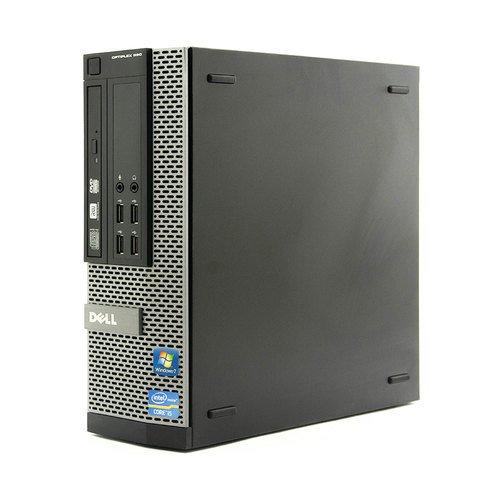

Ubuntu Studio
Made 2012, acquired refurbished in 2023.
CPU: Intel i7-2600 Quad Core 64-bit Hyperthreaded
(8 threads total), 3.4 GHz.
RAM: 16 GB DDR3 (maximum capacity)
Storage: 256 GB Samsung 850 EVO SSD,
DVD+-RW DL/CD-RW Optical drive.
Graphics: Nvidia GTX 1050 Ti with 4 GB of VRAM,
also Intel HD Graphics 2000 integrated
into the CPU with DP & VGA out.
Audio: Intel Q67 Express audio, stereo out,
microphone, line-in.
Connectivity: Ethernet 1 Gb, USB 3.0, 2.0, serial port,
WiFi dual band via external USB 3 dongle.
OS: Windows 10 64-bit
These machines are available refurbished from Amazon for around $120. I added the Nvidia GTX 1050 Ti graphics card which I got for $40 on eBay; it's a surprisingly capable card able to play videos at 4K and also older games such as Bioshock and even Crysis at 4K!
I also added an Inateck USB 3.0 card ($20) and an external high-speed dual-band WiFi dongle with antenna ($38). Connected to my home network, I'm able to stream modern games such as Cyberpunk 2077 from the AMD machine in my office to this machine connected to my bedroom TV.
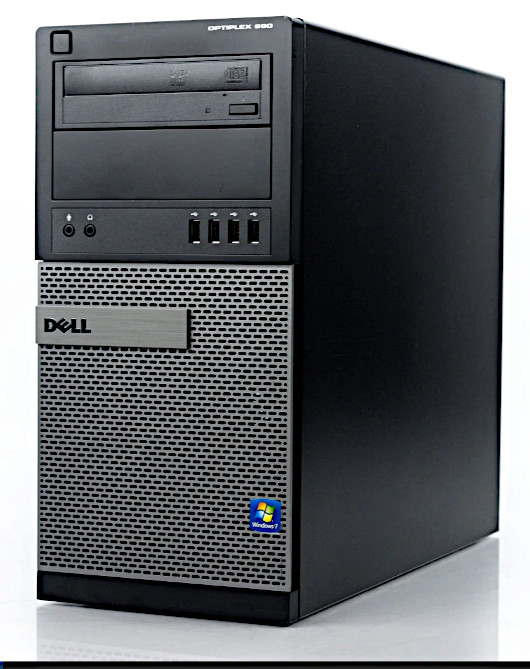
Made in 2009, purchased used April 2011.
CPU: Freescale i.MX1L SoC with ARM920T 32-bit core,
150 to 200 MHz.
RAM: 64 MB
Storage: 512 MB internal, 440 MB available for
books.
Graphics: Proprietary
Screen: 5" e-ink Vizplex screen 800 x 600 8-level grayscale
Audio: None
Connectivity: USB 2.0
O/S: Montavista Linux
Misc: Built-in battery can last up to
two weeks (7,500 page turns).
This unit uses the same screen technology as the Amazon Kindle (I eventually purchased a Kindle Paperwhite in 2023); it's readable even in direct sunlight (see photo at right) and draws very little power, allowing the device to go weeks before needing to be recharged.
Supported e-book document formats are ePub, Adobe PDF, BBebBook, TXT, RTF and Microsoft Word.
This device originally sold for $199 back in 2009; I got this used one for only $25 in 2011. Sony did not include an AC adapter for it (a $29 option), but I found later that the adapters that came with my Sony PSPs (see the Obsolete Computers page) are compatible.
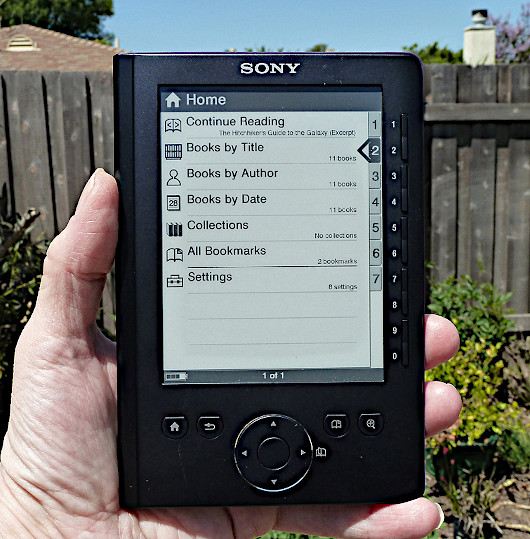
Made 2008, acquired 2018.
CPU: Intel Xeon E5472 3.0 GHz Quad Core 64-bit X 2
(dual CPUs, 8 Cores total).
RAM: 16 GB (expandable to 64 GB)
Storage: 320 GB hard drive,
DVD+-RW DL/CD-RW Optical "SuperDrive".
Graphics: Machine #1: EVGA Nvidia Geforce GTX 680 2 GB
Machine #2: ATI Radeon HD 2600 XT 256 MB
Audio: Optical Digital in and out ports,
plus analog stereo line in/out.
Connectivity: Dual Ethernet 1 Gb, USB 2.0,
Firewire 800, Bluetooth 2.0+EDR.
OS: Mac OS X 10.11 "El Capitan",
Microsoft Windows 10 64-bit (dual boot).
Acquired both machines for around $100 each. I upgraded the memory and also replaced the old standard ATI graphics card in one of the machines with a much newer and more powerful Nvidia GTX 680 "Mac" edition.
These machines are built to industrial standards; so they support up to two Xeon processors, dual Ethernet ports and ECC (error-correcting) memory, all components not normally found in consumer PCs.
2023 Update: Both machines have broken down, despite pouring lots of time & money into various repairs such as replacing the memory modules and a power supply. While they are built using industrial parts, these systems are surprisingly unreliable. Mac Pros from this era frequently suffer from power supply and motherboard failures. I may end-up having to sell these machines for parts. Luckily Nvidia cards with the special Mac-compatible BIOS are fairly rare; hopefully I should be able to get at least $200 for the GTX 680 card.
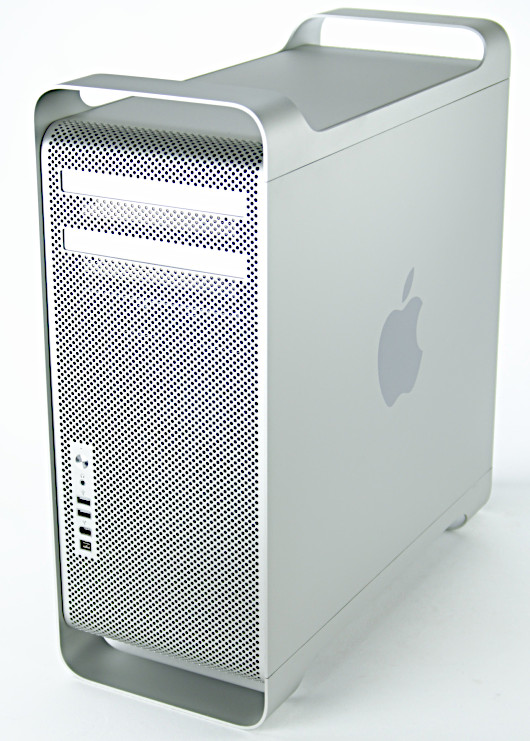
Made 2007, acquired 2022.
CPU: Intel Core 2 Duo T7700 Dual Core 2.4 GHz 64-bit
RAM: 4 GB DDR2 (maximum capacity)
Storage: 250 GB Samsung SSD 850 EVO,
DVD+R DL/CD Optical "Super Drive".
Screen: 20" LCD glossy TFT 1680 x 1050 pixels
Graphics: ATI Radeon HD 2600 Pro with 256 MB of VRAM,
HDMI-out port for second monitor.
Audio: Intel High-definition audio, stereo speakers,
microphone, headphone jack,
S/PDIF optical-out, line-in.
Connectivity: Ethernet 1 Gb, WiFi 802.11 a/b/g/n,
Bluetooth 2.0+ EDR, USB 2.0, Firewire 800.
Misc: Built-in camera.
OS: Apple OS X 10.11 ("El Capitan") 64-bit
This system was donated by a friend, and I set it up for my wife as her desktop computer in place of the Dell Windows All-In-One (see above), since she is more familiar with Apple devices.
With the acquistion of this machine I now have all three of the major iMac form-factors - the original late-Nineties CRT translucent "egg" version (see my Vintage Computers page), the 2003 LCD-on-an-arm edition (see my Obsolete Computers page) and this 2007 LCD "slab" aluminum model which is similar in form to the current version.

Built 2006-2007.
2023 Update: I kept this old system on my "current" list because, while it is probably too old to run Windows 10, technically it is still compatible with the current "lightweight" editions of Linux, due to its dual cores and 64-bit architecture.
Began work on original version May 16th, 2006. From January 2007 to March 2013 this system was my main computer. The system was upgraded numerous times; the specifications below describe it's current configuration.
CPU: Intel Pentium D 950 3.4 GHz Dual Core 64-bit
with 4 MB L2 Cache (2 MB per core)
RAM: 4 GB (first 2 GB Corsair XMS ProSeries
DDR2-675 sticks). System maximum
is 16 GB using 4 GB DIMMs.
Chipset: Nvidia nForce4 SLI X16
Motherbd: Asus P5N32-SLI Deluxe with 2 PCI-Express
16x slots, 1 PCI-Express 4x slot and
2 regular PCI slots.
Storage: Western Digital 320 GB WD3200 SE16
SATA 3.5” hard drive.
Western Digital 640 GB WD6400AAKS hard drive.
HP DVD-RW burner.
Microsoft XBOX 360 HD-DVD external USB drive.
Graphics: SLI dual card setup:
Two EVGA Nvidia Geforce 8800 GTS PCI-E cards
each with 640 MB of DDR3 memory and two
dual-link DVI ports
(max resolution 2560 x 1600 per monitor).
Audio: Realtek ALC850 AC'97 8 channel 16-bit 48 KHz
with both analog & digital S/PDIF outputs.
Connectivity: Dual Gigabit Ethernet, 10 USB 2.0 ports,
2 Firewire, 1 eSATA port.
Case: Thermaltake Tai Chi full size ATX/BTX
Special: Zalman Reserator 1 Plus Water-Cooling,
Zalman ZM-600HP 600 watt modular power-supply.
O/S: Triple boot configuration:
Windows XP Professional SP3
Windows Vista Business SP2
Windows 7 Ultimate 32-bit SP1
Under construction on-and-off for seven months, this system was designed to be state-of-the-art for 2006 with dual processor cores, support for dual video cards, up to four displays (three connected as of 12/08), water-cooling and over a terabyte of storage (6.2 TB attached as of 5/12).
The motherboard and power supply are designed support two PCI Express video cards, both at full 16x speed. I currently have two Nvidia 8800 GTS 640 MB cards in the system which can support as many as four monitors simultaneously.
The two cards are also physically joined together using a SLI bridge; SLI allows two cards to work together to improve the performance of graphically-intensive games such as Bioshock (see screen shot at right).
The Pentium-D 950 dual-core CPU is from Intel's Presler family; it consists of two 65 nm single-core processors packaged together. In early 2006 this was Intel's most advanced desktop CPU architecture, with support for both 32 and 64 bit operation along with Intel's virtualization technology known as 'Vanderpool'. Virtualization allows multiple operating systems to run simultaneously; an example of this would be Linux running in a window on a Windows XP desktop. Under Windows 7 which I installed in December of '09, I'm able to run Microsoft's Windows XP Mode VM software thanks to Vanderpool.
The motherboard in theory can support up to 16 Gigabytes of RAM, but when I tried to expand to that several years after building, the motherboard refused to boot with the higher capacity DIMMs. This taught me that when I build a system, I need to install the maximum RAM from the beginning to make sure it will work. However, memory beyond 4 GB does require an 64-bit operating system. Since 32-bit Windows only addresses up to 4 GB of memory, the video cards and other expansion-bus devices have to fit in that same address space, which reduces the 4 GB of physically installed RAM to 2.2 GB available to Windows.
To lower the noise a system like this would make, I used water cooling; this is the first time I've tried this technique. In the "under construction" photo at right, you can see the water hoses (the blue pipes) running from the chassis to an outside cooling radiator (the black tower). Three water blocks are currently installed; these are mounted on the CPU, the MOSFETs located next to the CPU and the Northbridge chip. Even with the water cooling some air circulation is still needed, so there are also three low-speed quiet fans mounted inside the case. To eliminate the noisy fan that a 600 watt power supply would normally need, I used a special external power supply unit (the XG Magnum EX).
Update 08/16/08: Added an internal Western Digital WD6400AAKS 640 GB SATA drive. This new drive fits 640 GB on to only two platters, making it one of the fastest, and for it's size and speed, one of the quietest currently available. Installed with rubber washers to reduce vibration.
Update 12/08: Added a second graphics card (the Asus overclocked 9500 GT) and a third display, a 22" Acer LCD monitor. A week later replaced my older 19" LCD display with a second 22" Acer (see photo at upper right of all three displays).
Update 5/09: The fancy XG Magnum EX external 600 watt silent power-supply the system was originally built with failed. Sadly these are no longer available, so I had to replace it with a more conventional internal power-supply made by Zalman.
Update 12/09: Made this a triple-OS machine by installing Windows 7 Ultimate on the third partition of the primary boot drive. With XP, Vista and 7 installed on different partitions I'm able to have all three versions of Windows available on the same machine although they do not run simultaneously; I have to reboot the machine to switch operating systems. However with Windows 7 I can at the same time run older versions of Windows using the Virtual Machine software provided by Microsoft.
Update 6/10: EVGA very kindly sent me a Geforce 8800 GTS 640 MB video card to replace my malfunctioning 7900 GTX (the system's original video card). I picked-up a second 8800 GTS from eBay so that I can run in SLI mode (SLI requires that both cards be identical).
Update 6/12: Installed another 2 GB of RAM to make 4 GB total. Sadly, available memory to 32-bit Windows increased by only 0.2 GB due to 32-bit address space limitations (see more detailed explanation above).

Asus P5N32-SLI Deluxe motherboard

System under construction showing water-cooling setup

2007 appearance (note external power supply on top)

2010 appearance

EVGA Geforce 8800 GTS
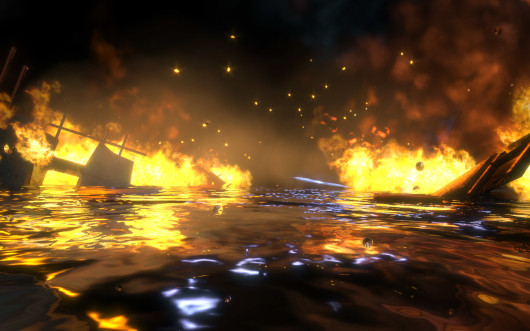
Bioshock on the Nvidia 8800 GTS
Made 2006, acquired 2023.
CPU: Intel Core 2 Duo T7200 Dual Core 2.0 GHz 64-bit
RAM: 4 GB DDR2 (maximum capacity)
Storage: 250 GB Samsung 850 EVO SATA SSD,
DVD+R DL/CD Optical drive.
Screen: 17" LCD matte 1440 x 900 pixels
Graphics: Nvidia Quadro FX 1500M with 256 MB of VRAM,
DVI, VGA & S-Video ports for external monitor.
Audio: Built-in stereo speakers & sub-woofer, microphone
jack, headphone jack, line-out.
Connectivity: Ethernet 1 Gb, WiFi 802.11 a/g, Bluetooth,
USB 2.0 x 6, Firewire, modem port (RJ11),
5-in-1 memory card slot.
Expansion: One Express card slot, Dell "D" docking port.
OS: Lubuntu 23.04 64-bit
This system was donated by a friend.
Back in 2006 this was Dell's top-of-the-line professional workstation laptop, equipped with the latest dual core 64-bit CPU and Nvidia's Quadro professional graphics GPU.
Originally shipped with Windows XP 64-bit on an 80 GB rotating drive. The Samsung SSD & a copy of Windows 10 was installed shortly before I acquired it in 2023. Unfortunately, Windows 10 did not support the old Nvidia Quadro GPU and the massive number of background tasks Windows runs was really dragging down the old dual-core CPU. I replaced Windows 10 with Lubuntu Linux, which is a light-weight version of the modern Ubuntu operating system optimized for older hardware. Lubuntu is able to run this machine at the proper video resolution thanks to the Linux open source driver for Nvidia GPUs; and the lower overhead allows this machine to perform much closer to the speed it had under Windows XP.

Installing Lubuntu on the Dell M90

Lubuntu desktop with some programs open (LibreCalc, Krita Paint, Files, FireFox)
Built 2006; purchased used in April 2011.
2023 Update: I kept this old system on my "current" list because, while it is probably too old to run Windows 10, technically it is still compatible with the current "lightweight" editions of Linux, due to its dual cores and 64-bit architecture.
CPU: Intel Pentium D 940 3.2 GHz Dual Core 64-bit
with 4 MB L2 Cache (2 MB per core)
RAM: 2 GB, expandable to 4 GB maximum
Chipset: Intel 945G Express
Storage: Seagate Barracuda 7200.7 120 GB 3.5"
7200 rpm SATA hard drive.
Toshiba-Samsung DVD+-RW Writer TS-L632.
Graphics: Asus Radeon HD 6570 1 GB VRAM
PCI-Express low-profile card.
Intel integrated CPU Graphics Media Accelerator
(GMA) 950.
Audio: 7.1 Surround 16-bit 48 KHz with both analog
& digital (S/PDIF) output.
Connectivity: 10/100 Mbit Ethernet, 7 USB 2.0 ports,
1 Firewire, 1 analog modem port.
Expansion: One 16x and one 1x PCI-Express slot.
O/S: Windows 7 Professional
I originally got the machine with no graphics card installed; the built-in Intel GMA 950 integrated graphics supports 1080p video playback but is not powerful enough for modern 3D games. Luckily the system has an 16x PCI-Express slot for an add-on graphics card; so I purchased & installed a new Radeon HD 6570 (see photo at right). The 6570 is the most powerful card I found that can fit into the the small case (only half-height cards are allowed) and can operate with the computer's small 275 watt power supply. "Fit" might be an overstatement; I had to sand down the plastic rail on an adjacent drive holder with #60 sandpaper before I could get the card with its big heat-sink to fit properly!
The Radeon 6570 was my first DirectX 11 card; also the first one to support the latest home theater technologies such as Stereoscopic 3D, Deep Color, xvYCC wide gamut 3D video and 7.1 high-bit rate audio (Dolby TrueHD and DTS Master Audio).
Under Windows 7, the 6570 has been able to play all of the modern games I've tested so far at high quality settings - Left for Dead 1 & 2, Bioshock and even Crysis. Note that these were all tested on a small 17" display (1280 x 1024); however I tested Bioshock on a bigger 20" Viewsonic VP201mp (1600 x 1200) and it ran fine.
The owners manual in PDF format.
9/14/11 Update: Acquired a used Logitech MOMO USB Racing wheel & pedals for playing driving games (see pic at right).


Windows 7 desktop on the Dell
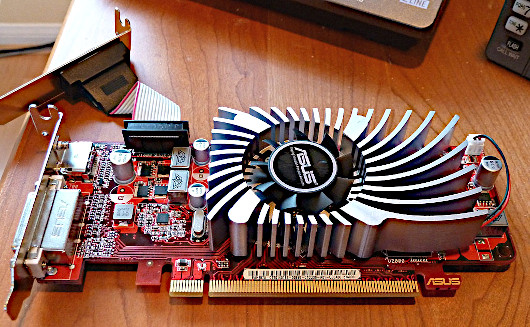
New Asus 6570 graphics card
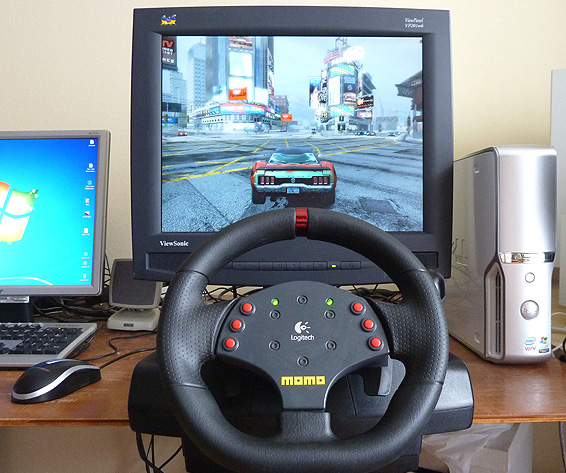
MOMO Racing wheel playing Burnout Paradise





